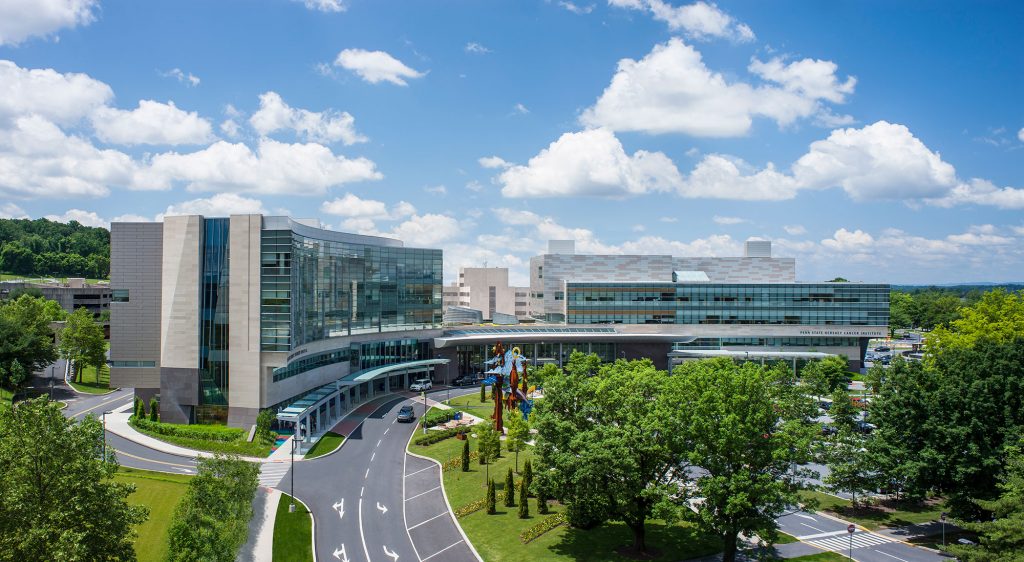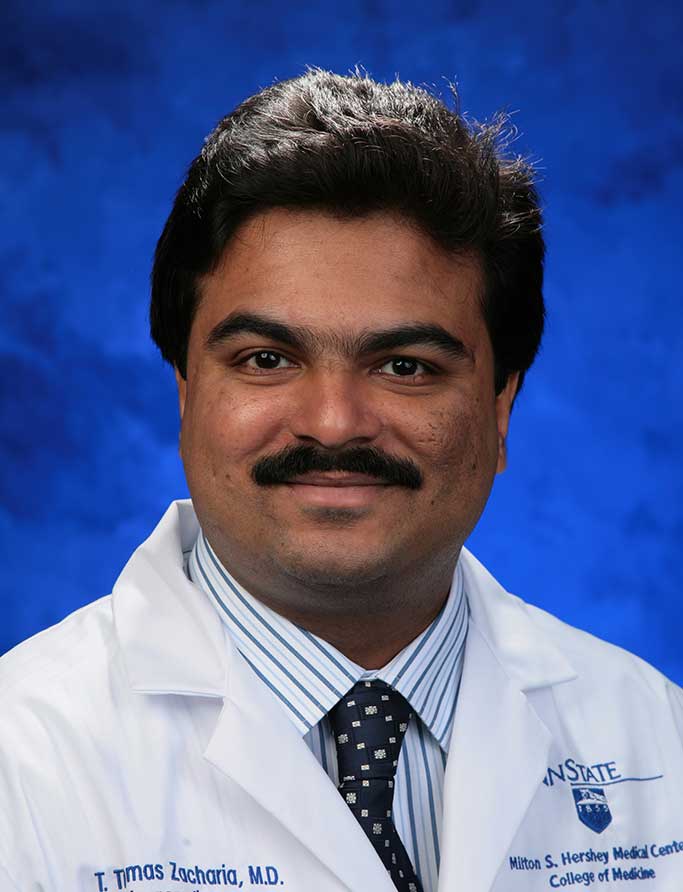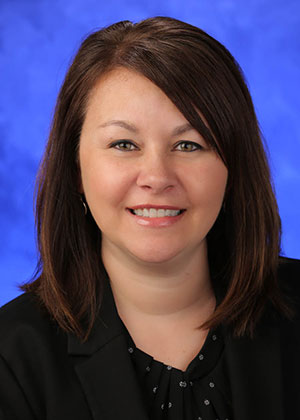Jump to topic
Search
Program Details
The Neuroradiology Fellowship provides training in the performance and interpretation of all aspects of neuroradiology, including magnetic resonance imaging, computed tomography, myelography and head and neck radiology. The fellowship also provides training in advanced CNS imaging, including MR spectroscopy, perfusion MRI, diffusion tensor MRI and CT perfusion and angiography.
As part of Penn State Spine Center, the fellowship offers extensive hands-on training in spine procedures such as vertebral augmentation, radiofrequency ablation, sacroplasty, epidural and facet injections, disc-related procedures and biopsies.
The fellowship is centered at Penn State Health Milton S. Hershey Medical Center and Penn State Children’s Hospital, which is adjacent to the medical center. This is the tertiary-care center for the central Pennsylvania area.
There are seven full-time ABR- and CAQ-certified neuroradiologists on staff. Fellows are supervised by staff neuroradiologists and are responsible for the performance and interpretation of all examinations under the supervision of staff neuroradiologists.
A multidisciplinary approach to neuroradiology training is emphasized. There is a close relationship of the clinical and academic activities of the Division of Neuroradiology with the Department of Neurology, Department of Otolaryngology – Head and Neck Surgery, Department of Neurosurgery, Division of Neuropathology, Department of Orthopaedics, Division of Pain Management and Department of Physical Medicine and Rehabilitation.
The department is entirely electronic with an excellent picture archiving and communication system as well as speech-recognition software.
Annually, the Division of Neuroradiology performs about 26,000 neuro CTs, 24,000 neuro MRIs and 1,400 neurovascular procedures.
Learn More about the Fellowship
All applications must be submitted through ERAS, and the program participates in the National Residency Matching Program. Applications will not be received outside of ERAS, and positions will not be filled outside the match.
The program will start reviewing applications in ERAS Dec. 1.
The American Society of Neuroradiology provides resources on the ERAS application process here.
Virtual Tour
Penn State Health
Penn State Health is a multi-hospital health system serving patients and communities across 29 counties of Pennsylvania. Its mission is to improve health through patient care, research, education and community outreach.
In December 2017, the system partnered with Highmark Health to facilitate creation of a value-based, community care network in the region. The shared goal of Highmark and Penn State Health is to ensure patients in the community are within:
- 10 minutes of a Penn State Health primary care provider
- 20 minutes of Penn State Health specialty care
- 30 minutes of a Penn State Health acute care facility
Learn more about Penn State Health

Penn State Health Children’s Hospital (left), Penn State Health Milton S. Hershey Medical Center (center) and Penn State Cancer Institute (right)
Penn State Health Milton S. Hershey Medical Center
500 University Dr., Hershey, Pa., 17033 (Derry Township, Dauphin County)
- The health system’s 647-bed flagship teaching and research hospital
- The only medical facility in Pennsylvania accredited as both an adult and a pediatric Level I (highest-level) trauma center
- Dedicated surgical, neuroscience, cardiovascular, trauma and medical intensive care units
- Accredited Life Lion critical-care transport providing more than 1,100 helicopter and approximately 750 ground ambulance transports per year
- More than 1,300 faculty members and more than 650 residents and fellows
- Approximately 29,000 admissions, 73,000 emergency department visits, 1.1 million outpatient visits and 33,000 surgical procedures annually
- Designated as a Magnet hospital since 2007
Learn more about Milton S. Hershey Medical Center
Penn State Health Children’s Hospital
600 University Dr., Hershey, Pa. 17033 (Derry Township, Dauphin County)
- An eight-story, 263,000-square-foot-facility built in 2013 and expanded in 2020
- 146 licensed pediatric beds, 18 acute care beds and a 56-bed neonatal intensive care unit
- Level IV (highest-level) neonatal intensive care unit
- Level I quaternary (highest-level) pediatric intensive care unit
- Level I (highest-level) pediatric trauma center designation
- Intermediate care unit
- Dedicated pediatric operating rooms
- More than 150,000 pediatric outpatient visits and approximately 5,000 pediatric patient discharges annually
Welcome to Hershey
More About Hershey
Interested in learning more about living and working in Hershey, Pa.? See details here:
Wellness, including emotional, spiritual, social and physical health, is a crucial component to training and to becoming a professional, compassionate and resilient physician. Self-care is a skill which must be continually practiced and reinforced. Penn State College of Medicine and Penn State Health are committed to addressing wellness among residents and fellows, with multiple resources readily available.
Institutional resources
- Visit BeWell – a health program designed to support Penn State Health employees
- See Penn State College of Medicine wellness resources here
- Employee Health Care Concierge and Case Management Service
- Partners in Medicine
Moving to a new city with your family does not have to be stressful. Residency programs have assisted many significant others with finding employment. There is also a GME-Wide Partners in Medicine (PIM) group that offers networking opportunities as well as various social and community oriented activities. - The Doctors Kienle Center for Humanistic Medicine
- Active and easily accessed Office of Professional Mental Health
Graduate medical education resources
Institutional Resources
Penn State Health and Penn State College of Medicine celebrate, embrace and support the diversity of all patients, faculty, staff, students and trainees.
Office for Diversity, Equity and Inclusion
In keeping with this, Penn State Health has an active Office for Diversity, Equity and Inclusion with various programs, networks and resource groups, including:
- Talks and lectures on diversity, equity and inclusion through the Inclusion Academy
- Regular events on topics such as eradicating racism and creating a culture of inclusiveness
- Many Business Employee Resource Groups (BERGs), including:
- Disability Business Employee Resource Group
- Interfaith Business Employee Resource Group
- LGBTQ+ Business Employee Resource Group
- Military and Veterans Business Employee Resource Group
- Multicultural Business Employee Resource Group
- NextGen Business Employee Resource Group
Learn more about the Penn State Health Office for Diversity, Equity and Inclusion
Learn more about the College of Medicine’s Office for Diversity, Equity and Belonging
Office for Culturally Responsive Health Care Education
The vision at Penn State College of Medicine and Penn State Health is to equip learners with the knowledge, skills and attitudes they will need to provide culturally excellent health care and research for an increasingly diverse U.S. population. The Office for Culturally Responsive Health Care Education was formed to help meet that goal.
Learn more about the Office for Culturally Responsive Health Care Education
Office for a Respectful Learning Environment
In addition, the institution does not tolerate discrimination, biases, microaggression, harassment or learner mistreatment of any kind, and any concerns are immediately addressed by the Office for a Respectful Learning Environment.
Learn more about the Office for a Respectful Learning Environment
Network of Under-represented Residents and Fellows
The Network of Under-represented Residents and Fellows (NURF) is a group of diverse residents and fellows representing all specialties. NURF’s goal is to promote cultural diversity in the residency programs through community involvement, mentorship with diverse faculty, professional networking and support for the recruitment of diverse medical students into the residency programs.
NURF is sponsored by the Penn State College of Medicine Graduate Medical Education Office and the Penn State Health Office for Diversity, Equity and Inclusion.
Mailing Address
Neuroradiology Fellowship
Department of Radiology
Penn State Health Milton S. Hershey Medical Center
500 University Dr.
P.O. Box 850, MC H066
Hershey, PA 17033
General Contact Information
Fax: 717-531-0006
Curriculum Details
The Neuroradiology Fellowship includes four core rotations, week-long on-call shifts, conferences and academic and research activities.
Diagnostic Neuroradiology
The Diagnostic Neuroradiology rotation encompasses general neuroradiology, brain, spine and head and neck imaging. This rotation provides exposure to the full gamut of neuroradiology studies, including CT, MRI, non-invasive CT and MR angiography, CT and MR perfusion studies, MR spectroscopy and myelography.
Interventional Spine
The Interventional Spine rotation (approximately two months) provides hands-on experience with both diagnostic and therapeutic spine procedures such as discograms, cervical and lumbar nerve root blocks, epidural steroid injections, facet blocks, lumbar drainage catheter placements, drainages and vertebral augmentations. Extensive experience in a wide range of CT-guided biopsies of the spine, intervertebral discs and paraspinal structures are also provided.
Neuroangiography
Neuroradiology fellows spend six weeks on the Neuroangiography service and take part in diagnostic cerebral angiography, acute stroke care, carotid stenting, aneurysm coiling, vascular malformation treatment and tumor embolization procedures. Fellows also participate in the structured vascular and neuroangiography online curriculum sponsored by the ASNR.
Pediatric Neuroradiology
Fellows will spend one day per week doing dedicated Pediatric Neuroradiology and are exposed to a variety of pediatric pathologies.
Required Diagnostic Examinations Interpreted
- Total diagnostic examinations interpreted: 3000 (Of which at least 1500 should be MR imaging).
- Vascular imaging interpretation: 250 (Including CTA, CTV, MRA, MRV, Doppler sonography, and catheter-based angiography).
Interventional
The fellowship provides hands-on experience with both diagnostic and therapeutic spine procedures such as epidural steroid injections, facet blocks, spine drainages and vertebral augmentations. Extensive experience in a wide range of CT-guided biopsies of the spine, intervertebral discs and paraspinal structures are also provided. Neuroradiology fellows are encouraged but not required to take part in diagnostic cerebral angiography, acute stroke care, aneurysm coiling and other neuro-interventional procedures.
Required Procedures
Image-guided invasive procedures performed: 100(Which may include LP, myelography, advanced spine procedures, catheter-based angiography, and head and neck biopsies).
Neuroradiology fellows take weeklong call on average one out of every four weeks during the year, consisting of in-house duty from 5 to 10 p.m. weekdays and either in-house or at-home duty on Saturdays and Sundays. After-hours call for emergent procedures is covered by pager from home.
Potential responsibilities on pager call include emergent lumbar punctures, myelograms and triage/performance of spinal interventional procedures. Fellows are provided with workstation at home and VPN access to enable workflow from home similar to that in-house.
Fellows are encouraged to present at neuroradiology societal meetings such as the ASNR annual meeting, ASHNR, ASSR or ASFNR. Past fellows have also presented work at RSNA and ARRS. Fellows are given approximately one-half an academic day per week to pursue scholarly activities.
In addition to the benefits provided to all Penn State Health Milton S. Hershey Medical Center employees, fellows are provided an educational funding allotment during the 12-month fellowship for expenses such as meeting attendance, travel expenses, electronic education materials and e-readers, etc. Read more about fellow benefits here.
Tuesdays
- 8 a.m.: Interesting case conference
Wednesdays
- 7:30 a.m.: Dedicated fellow didactic conference
Thursdays
- 8 a.m.: Rotates between multidisciplinary pediatric neuro conference, journal club, head and neck case conference, and pediatric interesting case conference
- 4 p.m.: Head and neck tumor board
Fridays
- 7 a.m.: Alternates between CNS tumor board and multidisciplinary spine conference
- 8 a.m.: Multidisciplinary neurosciences conference
- Six clinical MRIs (two 1.5T Siemens and four 3T Siemens)
- One research MRI (3T Siemens)
- Five MDCTs
- Dedicated CT scanner in emergency department (Siemens 256 detector dual energy)
- CT fluoroscopy suite
- Flat panel biplane Siemens Artis Angiogram equipment with DynaCT and rotational DSA capabilities
- PET/CT scanner (Phillips Gemini 16 slice)
- GE Centricity PACS (transitioning to Phillips PACS) with Powerscribe 360 Speech Recognition system
- Siemens and TeraRecon 3D reconstruction software with dedicated 3D lab with 3D printing capability
Cases seen in the program have included:
- Gadolinium-induced encephalopathy
- Balos concentric sclerosis
- Spinal cord sarcoidosis
- Abducens schwannoma
- Spinal cord hemangioendothelioma
- Variant CJD
- Amyotrophic lateral sclerosis
- Superior semicircular canal dehiscence
- Intergluteal dorsal dermal sinus
- Phalen McDermid syndrome
- Arboviral encephalitis
- S-adenosyltransferase deficiency
- MELAS
Latest News from Radiology





